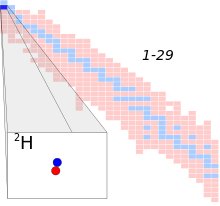
Back Deuterium Afrikaans ديوتيريوم Arabic دوتيريوم ARY Deuteriu AST Deyterium Azerbaijani Deutérium BAN Дэйтэрый Byelorussian Дэўтэр BE-X-OLD Деутерий Bulgarian ডিউটেরিয়াম Bengali/Bangla
 Deuterium isotope highlighted on a truncated table of nuclides for atomic numbers 1 through 29. Number of neutrons starts at zero and increases downward. Number of protons starts at one and increases rightward. Stable isotopes in blue. | |
| General | |
|---|---|
| Symbol | 2H |
| Names | Deuterium, hydrogen-2, 2H, 2H, H-2, hydrogen-2, D, 2H |
| Protons (Z) | 1 |
| Neutrons (N) | 1 |
| Nuclide data | |
| Natural abundance | 0.0156% (Earth)[1] |
| Half-life (t1/2) | stable |
| Isotope mass | 2.01410177811[2] Da |
| Spin | 1+ |
| Excess energy | 13135.720±0.001 keV |
| Binding energy | 2224.52±0.20 keV |
| Isotopes of hydrogen Complete table of nuclides | |
Deuterium (hydrogen-2, symbol 2H or D, also known as heavy hydrogen) is one of two stable isotopes of hydrogen (the other is protium, or hydrogen-1). The deuterium nucleus, called a deuteron, contains one proton and one neutron, whereas the far more common protium has no neutrons in the nucleus. Deuterium has a natural abundance in Earth's oceans of about one atom of deuterium among every 6,420 atoms of hydrogen (see heavy water). Thus deuterium accounts for about 0.0156% by number (0.0312% by mass) of all hydrogen in the oceans: 4.85×1013 tonnes of deuterium – mainly in form of HOD (or 1HO2H or 1H2HO) and only rarely in form of D2O (or 2H2O) – in 1.4×1018 tonnes of water. The abundance of deuterium changes slightly from one kind of natural water to another (see Vienna Standard Mean Ocean Water).
The name deuterium comes from Greek deuteros, meaning "second".[3][4] Deuterium was discovered by American chemist Harold Urey in 1931. Urey and others produced samples of heavy water in which the deuterium content had been highly concentrated. The discovery of deuterium won Urey a Nobel Prize in 1934.
Deuterium is destroyed in the interiors of stars faster than it is produced. Other natural processes are thought to produce only an insignificant amount of deuterium. Nearly all deuterium found in nature was produced in the Big Bang 13.8 billion years ago, as the basic or primordial ratio of 2H to 1H (about 26 atoms of deuterium per million hydrogen atoms) has its origin from that time. This is the ratio found in the gas giant planets, such as Jupiter. The analysis of deuterium–protium ratios in comets found results very similar to the mean ratio in Earth's oceans (156 atoms of deuterium per million hydrogen atoms). This reinforces theories that much of Earth's ocean water is of cometary origin.[5][6] The deuterium–protium ratio of the comet 67P/Churyumov–Gerasimenko, as measured by the Rosetta space probe, is about three times that of Earth water. This figure is the highest yet measured in a comet.[7] Deuterium–protium ratios thus continue to be an active topic of research in both astronomy and climatology.
- ^ Hagemann R, Nief G, Roth E (1970). "Absolute isotopic scale for deuterium analysis of natural waters. Absolute D/H ratio for SMOW 1". Tellus. 22 (6): 712–715. doi:10.1111/j.2153-3490.1970.tb00540.x.
- ^ Wang, M.; Audi, G.; Kondev, F. G.; Huang, W. J.; Naimi, S.; Xu, X. (2017). "The AME2016 atomic mass evaluation (II). Tables, graphs, and references" (PDF). Chinese Physics C. 41 (3): 030003-1–030003-442. doi:10.1088/1674-1137/41/3/030003.
- ^ Harold C. Urey; G. M. Murphy; F. G. Brickwedde (1933). "A Name and Symbol for H²". Journal of Chemical Physics. 1: 512–513. doi:10.1063/1.1749326.
- ^ O'Leary D (February 2012). "The deeds to deuterium". Nature Chemistry. 4 (3): 236. Bibcode:2012NatCh...4..236O. doi:10.1038/nchem.1273. PMID 22354440.
- ^ Hartogh P, Lis DC, Bockelée-Morvan D, de Val-Borro M, Biver N, Küppers M, et al. (October 2011). "Ocean-like water in the Jupiter-family comet 103P/Hartley 2". Nature. 478 (7368): 218–220. Bibcode:2011Natur.478..218H. doi:10.1038/nature10519. PMID 21976024. S2CID 3139621.
- ^ Hersant F, Gautier D, Hure JM (2001). "A two-dimensional model for the primordial nebula constrained by D/H measurements in the Solar system: Implications for the formation of giant planets". The Astrophysical Journal. 554 (1): 391–407. Bibcode:2001ApJ...554..391H. doi:10.1086/321355. — see fig. 7. for a review of D/H ratios in various astronomical objects
- ^ Altwegg K, Balsiger H, Bar-Nun A, Berthelier JJ, Bieler A, Bochsler P, et al. (January 2015). "Cometary science. 67P/Churyumov–Gerasimenko, a Jupiter family comet with a high D/H ratio" (PDF). Science. 347 (6220): 1261952. Bibcode:2015Sci...347A.387A. doi:10.1126/science.1261952. PMID 25501976. S2CID 206563296.